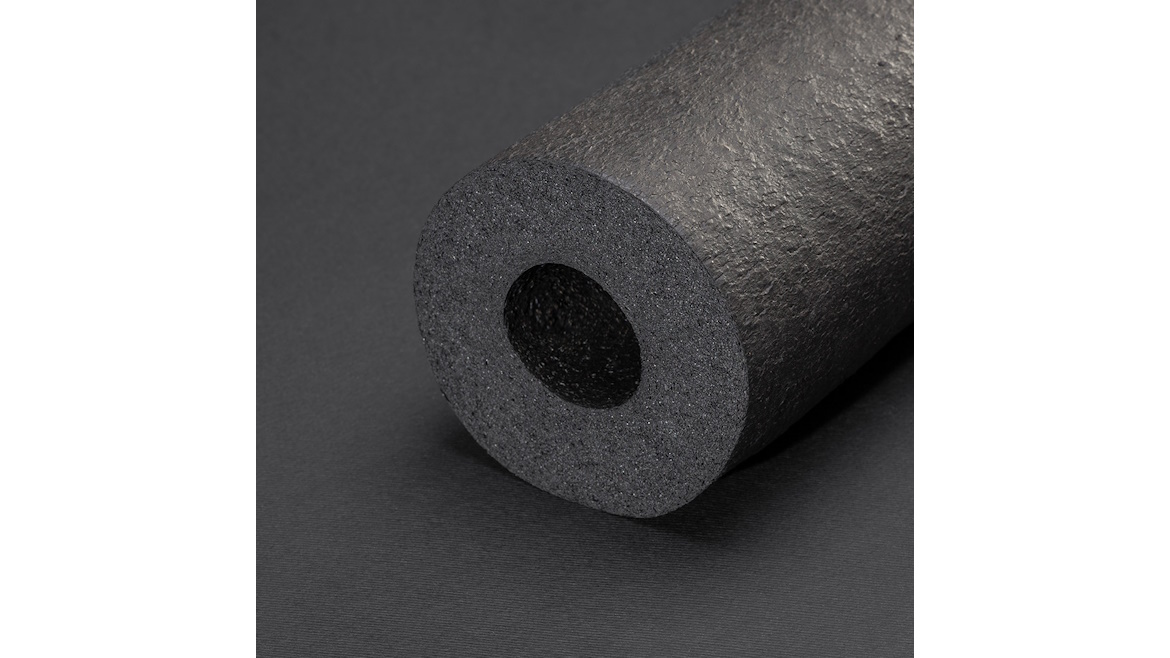On average, Americans spend 90% of their time indoors, with much of that time spent in commercial buildings such as offices, schools, hotels, and retail spaces. This extensive indoor presence underscores the importance of the environments within these commercial structures.
The quality of indoor air is significantly influenced by the selection of mechanical systems, particularly HVAC systems. The two most common types of insulation used in HVAC systems, closed-cell, and open-cell, are differentiated by their basic structures and performance characteristics.
Among the various HVAC insulation options available, elastomeric closed-cell foam duct insulation (closed-cell foam) solutions stand out for providing safe, sustainable, high-performance thermal and acoustic insulation while resisting moisture and improving overall indoor air quality (IAQ).
CLOSED-CELL FOAM IS ENGINEERED TO RESIST MOISTURE INTRUSION
In closed-cell foam products, the insulation is manufactured with a blend of acrylonitrile butadiene rubber (NBP) and polyvinyl chloride (PVC). In the “closed cell” structure of this elastomeric material, each individual cell is closed or sealed off from adjacent cells. These closed cells are highly resistant to moisture intrusion.
This structure prevents water from passing through the material and results in very low water vapor permeability (WVP) levels. Insulation with a low WVP ensures water does not penetrate or soak into the insulation.
While closed-cell foam is engineered to resist moisture, open-cell insulation is structured with hundreds of open cells, allowing water to travel freely and making the systems vulnerable to moisture intrusion, which can lead to mold growth and other hazards.
CONTROLLING MOISTURE PREVENTS MOLD GROWTH
Low WVP is critical to prevent condensation on the duct liner, which can lead to mold and bacterial growth and impact the building’s IAQ.
The experts agree: the EPA’s Indoor Air Quality Design Tools for Schools calls out the importance of selecting HVAC duct insulation that resists moisture intrusion. “While there is an ongoing debate about the wisdom of using insulation materials in duct systems that might retain moisture longer, all sides agree that extraordinary attention to preventing moisture contamination of the ductwork should be the primary strategy for preventing mold growth.”
Open-cell insulation in HVAC systems is prone to deterioration and leads to an elevated risk of moisture intrusion, which can promote the growth of mold, mildew, and bacteria. These factors can contribute to IAQ issues, potentially leading to health concerns including allergic reactions, asthma attacks, and irritation of the eyes, skin, nose, throat, and lungs and necessitating expensive replacement and remediation.
CLOSED-CELL FOAM INSULATION DOESN’T DEGRADE
Closed-cell foam is a non-particulating, non-eroding product that is essential for keeping foreign materials out of the indoor airstream. The composition of open-cell insulation presents a risk of materials breaking off and entering the airstream. These particles can circulate through building ventilation systems, potentially impacting respiratory conditions like asthma. This is especially important when planning for commercial environments with stringent cleanliness standards, such as hospitals or cleanrooms.
Further, closed-cell products are safe and easy to install. The materials are non-dusting, non-wicking, non-abrasive, and non-itching, which eliminates the need for personal protective equipment (PPE) during the installation. On the contrary, PPE is required during open-cell installation to minimize exposure to airborne materials which can irritate skin, eyes, and respiratory systems.
CLOSED-CELL FOAM KEEPS HVAC SYSTEMS RUNNING EFFICIENTLY
The closed-cell structure increases the durability of the insulation and, therefore, the long-term efficiency of the HVAC system. Moisture intrusion can degrade insulation in duct work and it reduces thermal efficiency over time.
By maintaining consistent performance over time, closed-cell solutions ensure sustained efficiency of the HVAC system. This includes maintaining a low K-value (thermal conductivity) and high R-value (thermal resistance), reducing energy use and costs. While the upfront cost of closed-cell foam is higher than alternative solutions, there can be significant savings, health, and indoor air quality benefits in the long term.
Notably, our closed-cell insulation products meet the ASTM C534 (American Society for Testing and Materials) standards and undergo regular third-party testing and certification to ensure safe use. From the raw materials to the formulas, the composition of these products is controlled, designed, and tested to provide consistent performance over time for consumers and contractors.
Closed-cell foam is an effective solution that provides durable, sustainable, high-performing thermal and acoustic insulation for contractors and the construction industry. It safely protects against condensation and moisture intrusion by being resistant to mold growth, leading to improved IAQ in commercial buildings.
Whether you require installation, repair, or maintenance, our technicians will assist you with top-quality service at any time of the day or night. Take comfort in knowing your indoor air quality is the best it can be with MOE heating & cooling services Ontario's solution for heating, air conditioning, and ventilation that’s cooler than the rest.
Contact us to schedule a visit. Our qualified team of technicians, are always ready to help you and guide you for heating and cooling issues. Weather you want to replace an old furnace or install a brand new air conditioner, we are here to help you. Our main office is at Kitchener but we can service most of Ontario's cities
Source link


Add Comment